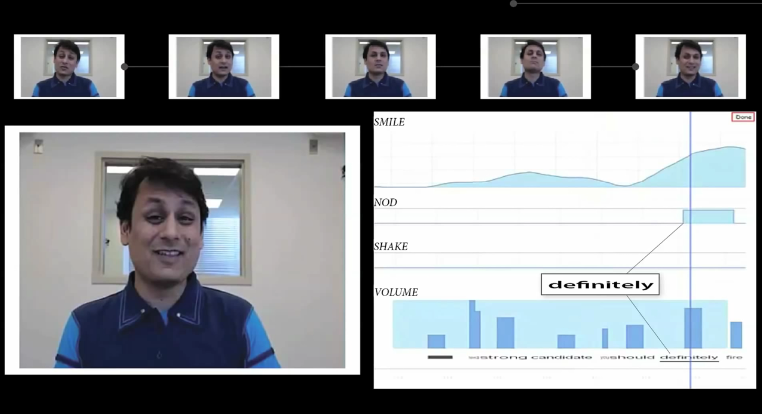Computer vision system developed at MIT allows successful interviews
At the Massachusetts Institute of Technology have developed a program to train communication skills . It works on a regular webcam computer. The program displays a three-dimensional animated character who “communicates” with a person and asks him questions. The program uses computer vision and speech recognition to maintain visual contact with a person. But the fun begins later. The program reproduces the recording of the conversation, accompanying it with detailed data on gestures, changing facial expressions, timbre and voice intonation, frequency of use of parasitic words like “in general”, “how-to”, “well”. This allows you not only to look at yourself from the side, but also to bring to the conscious level all those signs according to which people make an intuitive impression of the interlocutor.

The program, which the authors called MACH (My Automated Conversation coacH), was tested on 90 MIT students. They underwent two interviews at weekly intervals with professional recruiters specially hired for this purpose. After interviewing recruiters were asked to evaluate the "applicants" by filling out the questionnaire. Students were divided into three groups. The control group in the interval between the two interviews watched video tutorials on the techniques of the interview. The second group looked through the usual video recording of their interview. Third, I could study not only the video, but also all the analytics collected by MACH. A week later, the third group showed a statistically significant improvement in the results - recruiters often gave them high scores in the categories “overall impression”, “positive attitude to work”, more often answered positively to the question “Would you recommend hiring this person?”
')
Despite the rather schematic 3D model used in the program, the students noticed an unexpectedly natural impression of communicating with it - the authors made sure that the model watched the face of the person, nodded at the right moments, smiled in response to the person's smile.
The main developer, Ph.D., Ehsan Hawke , says that he worked on MACH for two years - this is part of his doctoral dissertation. He has plans to make the program available in the form of a web application or publish the source code, but this will take quite a lot of work - it has almost half a million lines of code. He hopes that his development will be able to find application not only for teaching communication skills or public speaking, but also for treating people with phobias, autism, Asperger syndrome, in pedagogy and in robotics. For everyone who wants to be the first to know about the appearance of MACH in the public domain, a subscription form has been created. So far, only an article in PDF has been published.
PS: About a year ago on Habré they wrote about a system that is capable of recording a person’s pulse on video. A webcam-based pulse detector that operates according to the same principle (Euler video zoom) was recently published on GitHub. It seems that quite a bit remains before the advent of lie detectors based on these technologies, which open up many interesting possibilities, for example, they will be able to record the speeches of politicians and high-ranking officials as input. Most likely, their use will quickly turn out to be illegal for everyone, except for secret service ...

The program, which the authors called MACH (My Automated Conversation coacH), was tested on 90 MIT students. They underwent two interviews at weekly intervals with professional recruiters specially hired for this purpose. After interviewing recruiters were asked to evaluate the "applicants" by filling out the questionnaire. Students were divided into three groups. The control group in the interval between the two interviews watched video tutorials on the techniques of the interview. The second group looked through the usual video recording of their interview. Third, I could study not only the video, but also all the analytics collected by MACH. A week later, the third group showed a statistically significant improvement in the results - recruiters often gave them high scores in the categories “overall impression”, “positive attitude to work”, more often answered positively to the question “Would you recommend hiring this person?”
')
Despite the rather schematic 3D model used in the program, the students noticed an unexpectedly natural impression of communicating with it - the authors made sure that the model watched the face of the person, nodded at the right moments, smiled in response to the person's smile.
The main developer, Ph.D., Ehsan Hawke , says that he worked on MACH for two years - this is part of his doctoral dissertation. He has plans to make the program available in the form of a web application or publish the source code, but this will take quite a lot of work - it has almost half a million lines of code. He hopes that his development will be able to find application not only for teaching communication skills or public speaking, but also for treating people with phobias, autism, Asperger syndrome, in pedagogy and in robotics. For everyone who wants to be the first to know about the appearance of MACH in the public domain, a subscription form has been created. So far, only an article in PDF has been published.
PS: About a year ago on Habré they wrote about a system that is capable of recording a person’s pulse on video. A webcam-based pulse detector that operates according to the same principle (Euler video zoom) was recently published on GitHub. It seems that quite a bit remains before the advent of lie detectors based on these technologies, which open up many interesting possibilities, for example, they will be able to record the speeches of politicians and high-ranking officials as input. Most likely, their use will quickly turn out to be illegal for everyone, except for secret service ...
Source: https://habr.com/ru/post/183898/
All Articles